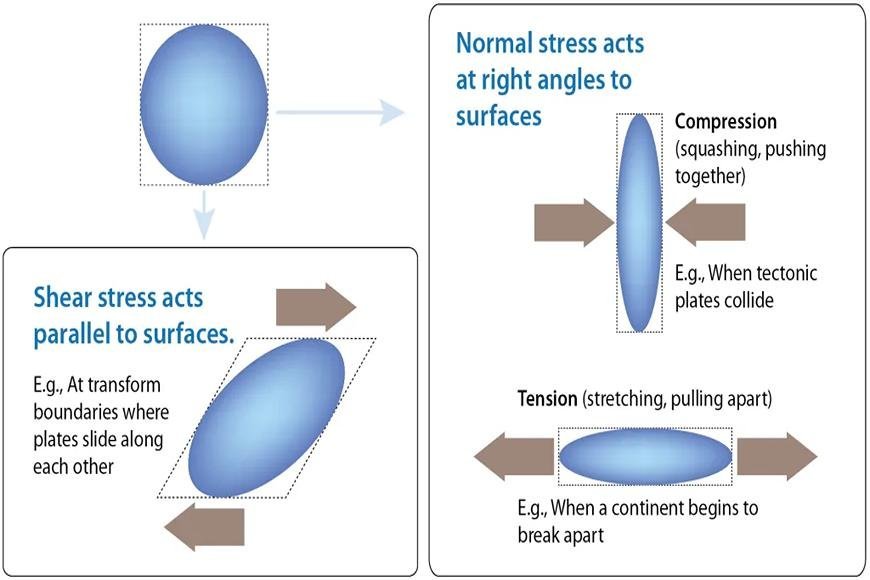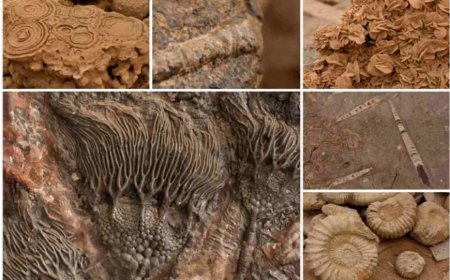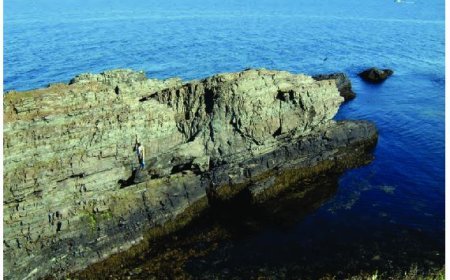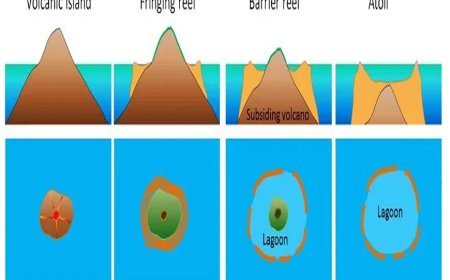STRESS AND STRAIN
Stress (force per area) strains (deforms) rocks, shaping mountains, faults, and Earth's story.

- Stress is the force per unit area acting on a rock, whereas strain is the subsequent deformation or change in shape of the rock.
- Stress is the force per unit area acting on a rock, whereas strain is the subsequent deformation or change in shape of the rock.
- Compressional stress, tensional stress, and shear stress are the three forms of stress.
- Compressional stress occurs when rocks are crushed or forced together, whereas tensional stress occurs when rocks are pulled apart or stretched.
- Forces that make rocks move past each other in different directions cause shear stress for rocks.
- Shear stress arises when rocks are exposed to pressures that cause them to slide past each other in opposing directions.
There are two kinds of strain: plastic strain and elastic strain.
- Elastic strain occurs when a rock deforms in response to tension but returns to its original shape when the load is removed.
- Plastic strain occurs when a rock deforms in response to tension and does not return to its original shape once the force is removed. Instead, the rock is permanently deformed.
- When exploring structure and geology, stress and strain are important ideas because they help us understand how rocks act during different types of tectonic and geological processes.
- Geoscientists may learn about a region's geological history as well as the possibility of geological hazards like earthquakes and landslides by examining stress and strain.
- Geologists can learn about a place's geological past and the chance of natural disasters like earthquakes and floods by looking at stress and strain.
- Geoscientists may learn about a region's geological history as well as the potential for geological hazards like earthquakes and landslides by examining stress and strain.
Types of stress
Compressional stress
- Compressional stress is a form of stress that arises when rocks are crushed or forced together. This form of stress is commonly related to tectonic processes such as plate convergence, in which two plates collide and press against each other.
- Under compressional stress, rocks can experience a variety of deformation processes, depending on their strength and the amount of stress applied.
- Compressional stress can occur in folding or faulting in weaker rocks, such as sedimentary rocks, when the rock layers are squeezed and distorted.
- Compressional stress can occur in the fracture or crushing of stronger materials, such as metamorphic or igneous rocks.
- Compressional stress can also have a significant impact on the creation of geological features such as mountain ranges.
- When two plates converge, the rocks between them are subjected to compressional stress, which can cause them to deform and elevate. This process can eventually result in the development of mountains.
- This process can eventually result in the development of mountains.
- Overall, compressional stress is an essential type of stress in structural geology, with substantial consequences for the deformation and development of rocks and geological structures.
- Geoscientists can learn more about the tectonic processes that shape the Earth's crust by researching compressional stress and its repercussions.
Tensional stress
- Tensional stress is a form of stress that happens when rocks are dragged apart or stretched.
- This form of stress is commonly related to tectonic processes such as divergent plate borders, which occur when two plates move apart from one another.
- This kind of stress is often linked to geological processes like divergent plate boundaries, which happen when two plates move away from each other.
Tension stress
- Under tensional stress, rocks can experience a variety of deformation processes, depending on their strength and the amount of stress applied.
- Tensional stress can cause the production of joints or fractures in weaker rocks, such as sedimentary rocks, when the rock layers are forced apart.
- Tensional stress can cause stretching or thinning in stronger materials, such as igneous or metamorphic rocks.
- Tensional tension can also have a significant impact on the creation of geological formations such as rift valleys.
- The rocks between two plates are put under tensional stress when they move apart. This can make the rocks stretch and thin. This process can result in the construction of a rift valley over time.
- This process can result in the construction of a rift valley over time.
- Overall, tensional stress is an essential type of stress in structural geology, with substantial consequences for the deformation and development of rocks and geological structures.
- Geoscientists can learn about the tectonic processes that shape the Earth's crust by researching tensional stress and its repercussions.
- Geoscientists can learn more about the tectonic processes that shape the Earth's surface by looking into tensional stress and its effects.
Shear stress
- Shear stress is a form of stress that arises when rocks are exposed to pressures that cause them to slide past each other in opposing directions.
- This sort of stress is commonly related to tectonic events such as transform plate borders, when two plates slide past one another.
- Rocks can undergo a variety of deformation processes under shear stress, depending on their strength and the amount of force applied.
- Shear stress can result in the creation of faults in weaker rocks, such as sedimentary rocks, where the rocks slide past each other along a plane of weakness.
- Shear stress in stronger materials, such as igneous or metamorphic rocks, can cause ductile deformation, in which the rock strata bend or fold.
- Shear stress may also have a significant impact on the creation of geological formations such as fault zones. When rocks are exposed to shear stress, they might develop zones of weakness along which they are more likely to deform in the future.
- These zones can become fault zones over time, which can have significant consequences for resource extraction as well as geological dangers like earthquakes.
- Overall, shear stress is an essential type of stress in structural geology, with considerable consequences for the deformation and development of rocks and geological structures.
- Overall, shear stress is a significant type of stress in structural geology. It has important effects on how rocks and geological structures change shape and form.
Overall, shear stress is an essential type of stress in structural geology, with considerable consequences for the deformation and development of rocks and geological structures.
Strain classification
Elastic strain
- Elastic strain is a sort of deformation that happens in a material when it is stressed but may return to its original shape and size once the load is removed.
- Under the imparted force, the material behaves elastically, much like a spring.
- When a substance is stressed, the bonds between its atoms expand or compress.
- In an elastic material, these linkages can briefly stretch or compress but then return to their original length once the tension is removed.
- This indicates that the material does not suffer lasting distortion or damage.
- The amount of elastic strain that a material can withstand is determined by its elasticity or stiffness.
- More elastic or stiffer materials, such as certain metals, can withstand greater levels of elastic strain before reaching their limit of elasticity, or yield point.
- When the yield point is exceeded, the material may experience plastic deformation, in which it permanently deforms and does not return to its previous shape when the stress is removed.
- Elastic strain is an essential topic in structural geology because it helps to understand the behavior of rocks under stress and how they deform over time.
- Geoscientists can get a better understanding of how rocks respond to different forms of stress and how they contribute to the production of geological structures such as faults, folds, and other deformation features by researching the elastic characteristics of rocks.
- Scientists who study rocks can learn more about how they react to different kinds of stress and how these qualities help form geological structures like cracks, folds, and other deformation features.
- Geoscientists can get a better understanding of how rocks respond to different forms of stress and how they contribute to the production of geological structures such as faults, folds, and other deformation features by researching the elastic characteristics of rocks.
Plastic strain
- Plastic strain is a sort of deformation that happens in a material when it is stressed beyond its elastic limit.
- Plastic strain is constant and unchangeable, unlike elastic strain. This means that the material doesn't go back to its original size and shape after the stress is taken away.
- Plastic strain, unlike elastic strain, is permanent and irreversible, which means that the material does not revert to its previous shape and size when the stress is removed.
- When a material is stressed beyond its elastic limit, the bonds between its atoms begin to break and reorganize. This causes persistent deformation in the material since the bonds are unable to recover to their former condition after the tension is released.
- A material's composition, structure, and the kind and amount of stress applied all influence how much plastic strain it can withstand.
- Some materials, such as metals and some types of rocks, may withstand substantial levels of plastic strain without fracturing or breaking, but others may fracture more quickly.
- Plastic strain is a key term in structural geology since it is responsible for the permanent deformation and creation of numerous geological features such as folds, faults, and shear zones.
- Plastic strain is a key term in structural geology since it is responsible for the permanent deformation and creation of numerous geological features such as folds, faults, and shear zones.
Stress and strain in rocks
- Stress and strain are crucial concepts in understanding the behavior of rocks during deformation.
- Tectonic forces, gravity, and variations in temperature and pressure are just a few of the factors that stress rocks.
- When rocks are stressed, they may deform, resulting in a change in shape or volume.
- The link between stress and strain is critical to understanding rock behavior.
- There are three forms of stress in rocks: compressional, tensional, and shear.
- Compressional stress occurs when rocks are pressed together, such as when two tectonic plates clash.
- Tensional stress arises when rocks are stretched apart, such as when two tectonic plates move apart.
- Shear stress occurs when rocks are forced in opposite directions, forcing them to slide past one another.
- When rocks are stressed, they can deform elastically, plastically, or shatter.
- Elastic deformation happens when a rock deforms under tension but returns to its original shape when the load is removed.
- Plastic deformation happens when a rock deforms permanently under force without shattering.
- Fracture happens when the tension on the rock surpasses its strength, causing the rock to break apart.
- A stress-strain curve generally describes the connection between stress and strain in rocks. This curve depicts how the rock responds to increasing stress and can aid in predicting the point at which the rock will undergo plastic deformation or fracture.
- The stress-strain curve for rocks generally contains three regions: elastic deformation, plastic deformation, and fracture.
What's Your Reaction?



































